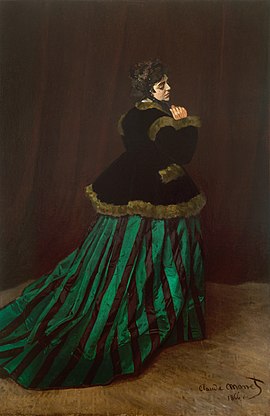art.wikisort.org - Painting
Camille, also known as The Woman in the Green Dress, is an 1866 oil-on-canvas painting by French artist Claude Monet. The portrait shows Monet's future wife, Camille Doncieux, wearing a green dress and jacket. Monet submitted the work to the Paris Salon of 1866, where it was well received by critics. The painting is held in the collection of the Kunsthalle Bremen.[1]
| Camille | |
|---|---|
 | |
| Artist | Claude Monet |
| Year | 1866 |
| Medium | Oil on canvas |
| Dimensions | 231 cm × 151 cm (91 in × 59 in) |
| Location | Kunsthalle Bremen |
Description
Camille in the Green Dress is a life size portrait. Camille wears a green and black striped silk dress over a black jacket trimmed with fur. The dress in emerald green corresponded to the fashion of the time with the contrasting vertical stripes. Yellow leather gloves and a dark capote decorated with feathers serve as accessories. Camille wears her hair in a bun tied with black ribbons at the nape of her neck. The background of the picture is a dark red, almost black curtain.[2]
Through the composition of the image, Monet succeeded in conveying movement. The train of the dress has been cut off at the left edge of the picture, causing a movement in this direction that goes beyond the edge of the picture. Liveliness is also created by the play of the folds in the skirt. The slightly backward-turned position of the head represents a moment of pause in the picture. The figure seems to be listening to itself rather than reacting to someone speaking to it. This is achieved through the downcast eyes and thereby avoiding eye contact with the viewer. The painting is signed lower right Claude Monet 1866.[3]
The lighting of the this picture unique in that it is diffused and the origin of it is obscure. We see kind of a semi circle of light surrounding Camille on the floor and source is particularly highlighting her face, hand and skirt. Light is probably coming from a window since it is too natural looking to be produced by candles or gas lamps.[4] The placement of the window is hard to tell but it’s probably to the left and in front of her as her shadow is cast to the right but her face and skirt are still highlighted.[5]
References
- Gedo, Mary Mathews (2010). Monet and His Muse: Camille Monet in the Artist’s Life. University of Chicago Press. ISBN 9780226284804
- Graf, E. (1981). "Große Gemäldegalerien. Hrsg. Erich Steingräber. Hirmer Verlag, München 1980. 606 S. 34 × 31 cm, 344 farbige Tafeln im Großformat. Lw., DM 128,—". Pharmazie in Unserer Zeit. 10 (3): 90–90. doi:10.1002/pauz.19810100308. ISSN 0048-3664.
- Gudian, Janus (September 2012). "Handbuch der Religionsges (Hrsg.), Handbuch der Religionsgeschichte im deutschsprachigen Raum in 6 Bänden. Hrsg. v.Peter Dinzelbacher. Bd. 1: Altertum und Frühmittelalter. Hrsg. v.Peter Dinzelbacher. Paderborn/München/Wien, Schöningh 2011 Handbuch der Religionsges Handbuch der Religionsgeschichte im deutschsprachigen Raum in 6 Bänden. Hrsg. v.Peter Dinzelbacher. Bd. 1: Altertum und Frühmittelalter. Hrsg. v.Peter Dinzelbacher. 2011 Schöningh Paderborn/München/Wien € 94,–". Historische Zeitschrift. 295 (1): 124. doi:10.1524/hzhz.2012.0358. ISSN 0018-2613.
- Corcoran, Cate (2019-08-20). "Lighting in the 19th Century Row House". Brownstoner. Retrieved 2022-04-12.
- "A Beginners Guide to Light & Shadow : Part 1". will kemp art school. 2014-03-27. Retrieved 2022-04-12.
Further reading
- Hansen, Dorothee (2005). Monet und "Camille": Frauenportraits im Impressionismus. Ed. Dorothee Hansen and Wulf Herzogenrath. Exh. cat., Kunsthalle Bremen. Munich.
External links
- Camille at the Kunsthalle Bremen
На других языках
[de] Camille im grünen Kleid
Camille im grünen Kleid, auch als Camille oder Die Dame im grünen Kleid bekannt, ist ein im Jahre 1866 von Claude Monet gemaltes Porträt. Das 231 Zentimeter hohe und 151 Zentimeter breite, mit Öl auf Leinwand gemalte Bild zeigt Monets spätere Frau Camille Doncieux, die ein Ensemble aus einem grünen Kleid und einer Jacke trägt. Monet reichte das Bild zum Pariser Salon des Jahres 1866 ein, wo es bei den Kritikern Anklang fand und für ihn einen besonderen Erfolg bedeutete. Heute gehört das Porträt zur Sammlung der Bremer Kunsthalle.- [en] Camille (Monet)
[fr] La Femme à la robe verte
En 1866, Claude Monet peint La Femme à la robe verte représentant Camille Doncieux. Le tableau a rencontré un vif succès au Salon de peinture et de sculpture où il fut exposé, attirant sur Monet une gloire soudaine.Другой контент может иметь иную лицензию. Перед использованием материалов сайта WikiSort.org внимательно изучите правила лицензирования конкретных элементов наполнения сайта.
WikiSort.org - проект по пересортировке и дополнению контента Википедии